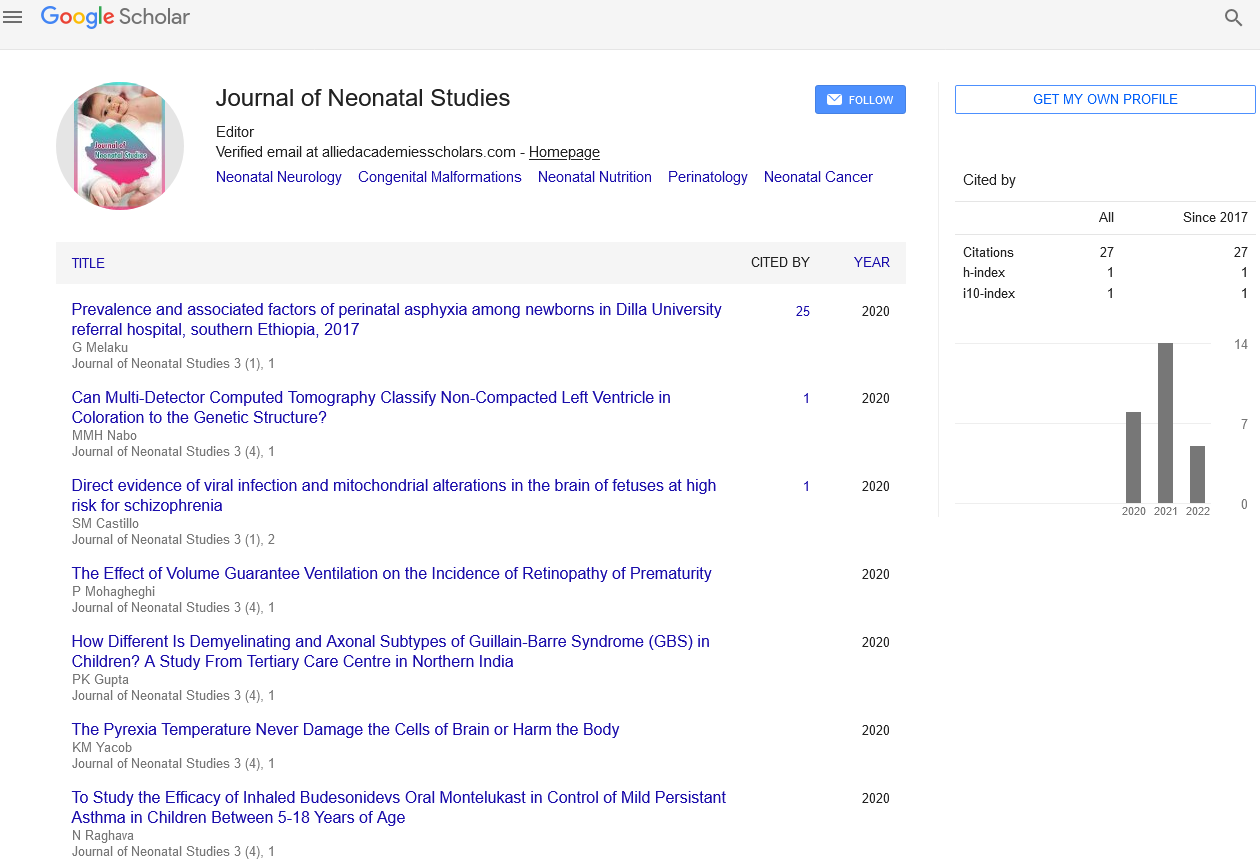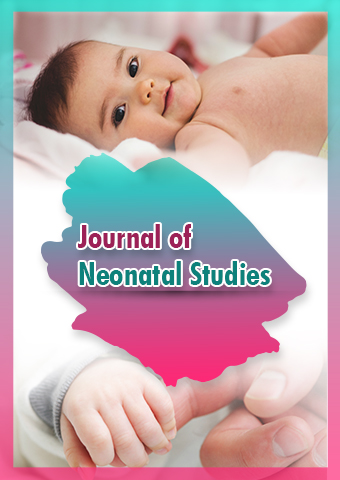Review Article - Journal of Neonatal Studies (2023) Volume 6, Issue 3
Understanding Neonatal Necrotizing Enterocolitis: Causes, Symptoms, and Treatment
Ma Panjiang*
Department of Medicine, Affiliated People’s Hospital of Ningbo University, Ningbo 315040, China
Department of Medicine, Affiliated People’s Hospital of Ningbo University, Ningbo 315040, China
E-mail: 20143316qq@stu.nun.edu.cn
Received: 01-June-2023, Manuscript No. jns-23-104258; Editor assigned: 2-June-2023, PreQC No. jns-23- 104258(PQ); Reviewed: 15-June- 2023, QC No. jns-23-104258; Revised: 23-June-2023, Manuscript No. jns-23- 104258(R); Published: 30-June-2023; DOI: 10.37532/jns.2023.6(3).67-69
Abstract
Neonatal Necrotizing Enterocolitis (NEC) is a serious gastrointestinal disease that primarily affects premature infants. It is characterized by inflammation and damage to the intestines, leading to tissue death, and it is considered one of the most devastating conditions affecting newborns. This article aims to provide an overview of NEC, including its causes, symptoms, and available treatment options. Neonatal Necrotizing Enterocolitis (NEC) is a severe condition that primarily affects premature infants, causing inflammation and necrosis in the intestines. It is a leading cause of morbidity and mortality in neonates, particularly in those born before 32 weeks of gestation. This article aims to provide an overview of NEC, including its causes, symptoms, and treatment options.
Keywords
Neonatal mortality • Gastrointestinal disease • Premature • Inflammation • Morbidity
Introduction
Causes
The exact cause of NEC remains unclear, but several factors are believed to contribute to its development. Prematurity is a significant risk factor, as babies born before 32 weeks gestation or with a low birth weight are more susceptible. The immature intestines of premature infants may have difficulty handling feedings, leading to intestinal damage. Other contributing factors include a compromised blood supply to the intestines, an imbalance in gut bacteria, and a weakened immune system [1].
Symptoms
The symptoms of NEC can vary in severity but may include:
Feeding intolerance: Infants may have difficulty tolerating feedings, resulting in abdominal bloating, vomiting, and poor weight gain.
Abdominal distension: The abdomen may appear swollen or distended due to the accumulation of gas or fluid.
Bloody stools: Blood may be present in the baby’s stools, indicating intestinal bleeding. Lethargy: Infants with NEC may exhibit decreased activity, decreased responsiveness, or a lack of interest in feeding.
Temperature instability: Fluctuations in body temperature, such as hypothermia or fever, can be observed.
Respiratory distress: Some babies may experience difficulty breathing, rapid breathing, or require respiratory support [2].
Discussion
Diagnosis and treatment
Early detection of NEC is crucial for better outcomes. A combination of clinical signs, physical examination, and diagnostic tests is used for diagnosis. These tests may include blood tests, abdominal X-rays, and, in some cases, an ultrasound or exploratory surgery.
The treatment for NEC typically involves a multidisciplinary approach involving neonatologists, pediatric surgeons, and other healthcare professionals. The primary goal is to stabilize the baby’s condition and address complications promptly. Treatment options may include:
Temporary cessation of feeding: To rest the intestines, feeding is usually temporarily stopped, and the baby receives intravenous fluids for nutrition.
Antibiotics: Broad-spectrum antibiotics are administered to treat or prevent infection.
Nasogastric decompression: A tube is inserted through the nose or mouth into the stomach to relieve pressure and remove excess gas or fluid [3].
Surgery: In severe cases of NEC, where a hole or perforation in the intestine is present, surgery may be necessary to remove the damaged portions of the intestine.
Prevention and outlook
Preventing NEC remains a challenge, but certain measures can help reduce the risk. These include promoting breastfeeding, practicing proper hygiene and infection control in the neonatal unit, and minimizing the use of unnecessary antibiotics. Additionally, efforts to minimize premature births through prenatal care are vital.
The outlook for infants with NEC depends on various factors, including the severity of the disease and how early it is detected. With prompt diagnosis and appropriate treatment, many infants can recover. However, NEC can lead to long-term complications such as short bowel syndrome, impaired growth, and developmental delays.
Neonatal Necrotizing Enterocolitis (NEC) is a complex and potentially devastating condition that poses significant challenges in neonatal care. This discussion aims to explore the impact of NEC on infants, healthcare providers, and families, as well as the challenges associated with its diagnosis, management, and long-term outcomes [4].
Impact on infants
NEC can have a profound impact on the health and well-being of affected infants. The inflammatory process and tissue necrosis in the intestines can lead to serious complications, including bowel perforation, sepsis, and longterm gastrointestinal dysfunction. The associated morbidity and mortality rates, particularly among premature infants, highlight the urgent need for early detection and effective treatment strategies [5, 6].
Challenges in diagnosis
Diagnosing NEC can be challenging due to its varied presentation and overlapping symptoms with other neonatal conditions. Early signs may be subtle, making it crucial for healthcare providers to maintain a high index of suspicion. Furthermore, diagnostic tools such as abdominal X-rays and blood tests may not always provide definitive results, necessitating a multidisciplinary approach and close monitoring for timely intervention.
Management strategies
The management of NEC involves a multidimensional approach, encompassing supportive care, infection control, and, in severe cases, surgical intervention. Providing supportive care while maintaining adequate nutrition and hydration is crucial for the healing process. Balancing the need for bowel rest and the initiation of enteral feeds presents a delicate challenge, as both underfeeding and overfeeding can have adverse effects. In addition, the administration of antibiotics should be carefully monitored to avoid the emergence of antibioticresistant strains [7, 8].
Surgical interventions and long-term outcomes
Severe cases of nec often require surgical intervention, which adds another layer of complexity to the management process. Surgical procedures may involve the removal of necrotic bowel segments or the creation of stomas, posing long-term implications for intestinal function and potential complications such as short bowel syndrome. The long-term outcomes of infants who survive NEC can vary, with some experiencing gastrointestinal complications, growth and developmental delays, and an increased risk of neurodevelopmental disorders.
Emotional impact on families
NEC not only affects the infants but also places significant emotional strain on families. Parents may experience feelings of helplessness, guilt, and anxiety as they navigate the challenges associated with their child’s diagnosis and treatment. Adequate support from healthcare professionals, including clear communication, counseling, and access to support groups, is vital in assisting families through this difficult journey.
Research and prevention
Given the serious consequences of NEC, ongoing research is essential to enhance our understanding of the condition and develop effective prevention strategies. Promoting breastfeeding, implementing careful feeding protocols, and maintaining rigorous infection control practices have shown promise in reducing the incidence of NEC. Continued research efforts are needed to identify additional risk factors, refine preventive measures, and improve outcomes for infants at risk [9, 10].
Conclusion
Neonatal Necrotizing Enterocolitis is a complex and challenging condition with significant implications for infants, families, and healthcare providers. Timely diagnosis, multidisciplinary management, and ongoing research efforts are crucial for improving outcomes and reducing the burden of NEC. By addressing the impact of NEC comprehensively and collaboratively, we can strive to enhance the care and well-being of vulnerable neonates and support their families throughout this challenging journey.
Neonatal Necrotizing Enterocolitis is a serious condition that demands immediate attention and specialized care. Early detection, proper management, and prevention strategies are crucial in reducing the impact of NEC on premature infants. Through ongoing research and advancements in neonatal care, medical professionals continue to work towards improving outcomes for infants affected by this challenging condition. Neonatal necrotizing enterocolitis is a serious condition that primarily affects premature infants. Understanding its causes, recognizing the symptoms, and providing prompt treatment is crucial for better outcomes. By implementing preventive strategies, promoting breastfeeding, and ensuring optimal care in neonatal units.
Acknowledgement
None
Conflict of Interest
None
References
- O'Farrell P, Ferreira N. Digital photography in orthopaedics: Ethical considerations. SA Orthop J. 15, 91-4 (2016).
- Brandl D, Prantl L. Fotodokumentation ästhetischer Behandlungen. Journal für Ästhetische Chirurgie. 12, 84-94 (2019).
- Arimany Manso J, Taberner Ferrer R, Pidevall I et al. Use of Photography in Dermatology: Ethical and Legal Implications. Actas Dermosifiliogr. 111, 107-14 (2020).
- Creighton S, Alderson J, Brown S et al. Medical photography: ethics, consent and the intersex patient. BJU Int. 89, 67-71 (2002).
- Grassberger M, Verhoff MA. Klinisch-forensische Fotodokumentation. Klinisch-forensische Medizin: Springer. pp: 127-38 (2013).
- Eichhorn C, Nagel E. Fotodokumentation. Prävention und Gesundheitsförderung. 4, 207-16 (2009).
- Karim RB, Hage JJ, Ahmed AK et al. Digital photography as a means of enhancing interconsultant communication in oncological cutaneous surgery. Ann Plast Surg. 48, 180-3 (2002).
- DeLange GS, Diana M. 35 mm film vs. digital photography for patient documentation: is it time to change? Ann Plast Surg. 42, 15-9 (1999).
- Galdino GM, Swier P, Manson PN et al. Converting to digital photography: a model for a large group or academic practice. Plast Reconstr Surg. 106, 119-24 (2000).
- de Almeida Geraldino R, Rezende L, da-Silva CQ et al. Remote diagnosis of traumatic dental injuries using digital photographs captured via a mobile phone. Dent Traumatol. 33, 350-7 (2017).
Indexed at, Google Scholar, Crossref
Indexed at, Google Scholar, Crossref
Indexed at, Google Scholar, Crossref
Indexed at, Google Scholar, Crossref
Indexed at, Google Scholar, Crossref
Indexed at, Google Scholar, Crossref

